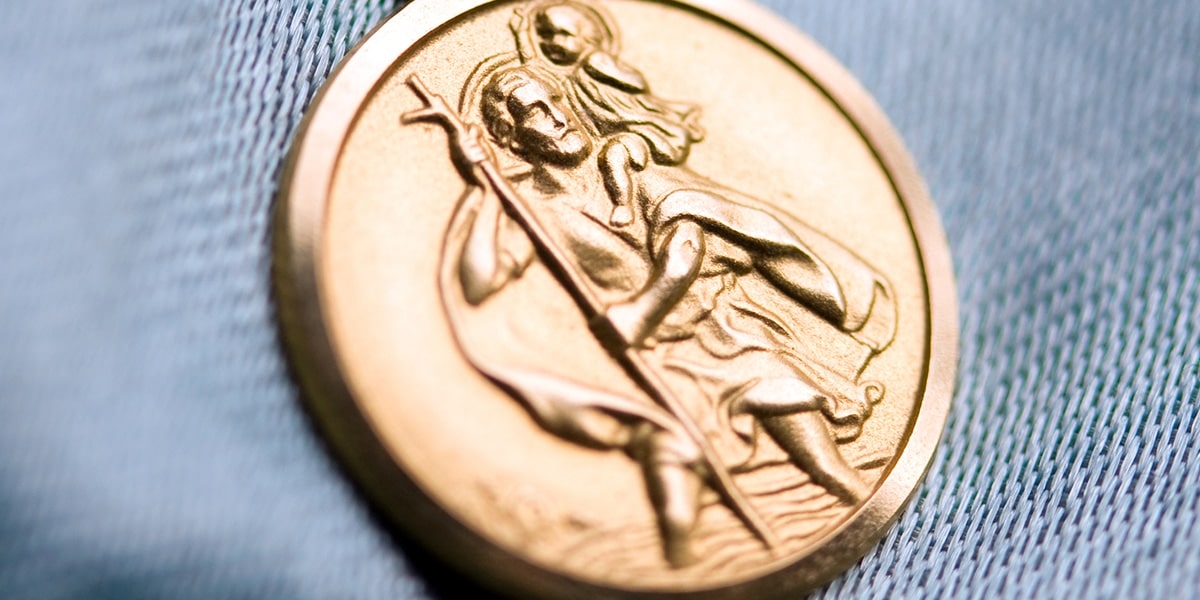St. Christopher—patron of travelers—is one of the most endearing for Catholics. His life and story, bordering somewhere between legend and legitimacy, is an exercise in service, grace, and love.
There is a beloved saint who was ousted from the Roman calendar in 1969. His image can be found inside of cars, on the walls of churches, and around the necks of safety-seeking travelers. His most prevalent image is that of a tall, formidable man who wades across an unruly river. Wooden staff firmly in hand, his face is often strained, looking upward to the sweet-faced child resting on his oversized shoulders.
He is referenced in literature: “A Cristofre on his breast of silver shene,” Chaucer wrote in The Canterbury Tales; and in film, such as 2005’s Crash in which a habitual car thief uses his trusty St. Christopher medal as a good-luck charm.
Christopher has proven his resilience, growing in popularity over the centuries and withstanding suspicious historians who have questioned his validity.
The Wounded Wanderer
He was a man of many names, Offerus being one of them. Born in the third century in Asia Minor, son of a king, he would grow to be a restless young man of considerable size. The early years of his life were spent in search of riches, of purpose, of a cause worthy of his allegiance.
As the story goes, a young Offerus, looking for the strongest and boldest ruler to follow, briefly courted Satan. When his new master cowered in fear at a holy cross on the side of a road, Offerus abandoned Satan, choosing light over darkness. During this period of transition, a holy hermit awakened the restless wanderer to Christianity, schooling and baptizing him. From then on, Offerus pledged his life to Christ and vowed to serve God’s people along the banks of an untamed river. So he built a hut and set up camp with a new purpose—to be a boatman to the world.
His popularity was solidified when a small child once approached him, wanting safe passage across the water. He hoisted the boy on his shoulders and, with his trusty staff, began the journey. As the river deepened, the child began to grow heavier. Waters quickly rising, the precious cargo continued to weigh the giant down. According to historians, as he reached the banks of the river, Offerus said, “Child, thou hast put me in great peril; thou weighest almost as if I had all the world upon me: I might bear no greater burden.”
“Christopher,” the little boy responded, “thou hast not only borne all the world upon thee, but thou hast borne Him that created and made all the world, upon thy shoulders.”
The child instructed Christopher (meaning “Christbearer”) to cross the river again and plant his staff in the ground, telling the ferryman that life would spring forth. To Christopher’s astonishment, by morning his staff had taken root—bright flowers and fruit grew from it.
The rest of Christopher’s life is even sketchier in detail. One legend states that many in the immediate area converted to Christianity based on his encounter, which drew unwanted attention. In Lycia—present-day Turkey—under Emperor Decius, he was imprisoned, shot with arrows, burned and then beheaded around 251 A.D.
Though the life of this mighty martyr was later questioned by historians, St. Christopher’s story and his worldwide appeal have proven invulnerable.
St. Christopher’s Legacy
Did Christopher really exist or is his life a work of fiction? Dr. Lawrence Cunningham, author and John A. O’Brien Professor of Theology at the University of Notre Dame, believes the his life is, indeed, rooted in truth.
“It’s not clear, but there probably was a martyr during the period of Decius with whom all kinds of stories got identified,” Cunningham says. “And one of the ones that lasted was that he was a person who took people across a river and was given a name that means ‘one who bears Christ.'”
St. Christopher’s popularity, like his giant staff, bore much fruit. According to Francis Mershman in the Catholic Encyclopedia, Volume III, a brotherhood that guided travelers over a massive Alpine pass in Tyrol and Vorarlberg was founded in 1386 under his patronage.
In the early 16th century, a St. Christopher temperance society was active in European areas such as Carinthia, Saxony, Styria and Munich. A picture of Christopher was found in a monastery on Mt. Sinai dating from the time of Justinian (527-565). His image was cast on coins in Bohemia, and his statues could be found on bridges, imparting safety to their many travelers.
Christopher’s woodcarvings and paintings were hung on the walls of many European churches, often accompanied by the inscription, “Whoever shall behold the image of St. Christopher shall not faint or fall on that day.” Further proof of his early popularity, St. Christopher was included as someone invoked against an assortment of hardships. He was also chosen as the patron of Baden, Brunswick and Mecklenburg.
And that popularity never wavered. Even somewhat recently, organizations such as “The Christophers,” founded by Father John Keller, M.M., in 1945, are named after him. The Christophers’ purpose is to encourage all individuals to celebrate “their abilities and use them to raise the standards in all phases of human endeavor.” It’s a fitting principle.
Despite St. Christopher’s long-lasting influence, aspects of his life are shrouded in myth and in legend. But Cunningham believes his popularity, regardless of overwhelming uncertainty, is unmistakable. “I think what happened was that St. Christopher entered into the popular culture. He became an icon well beyond whatever historical veracity we have relative to his name.”
An Identity Crisis
Worldwide popularity and admiration aside, Christopher’s legitimacy has always challenged him. In the 16th century, Desiderius Erasmus, a Dutch humanist and writer, argued against him in The Praise of Folly. Erasmus, who Cunningham charges with an “acidic pen,” believed that the cult of St. Christopher was simply a retelling of the Hercules legend because of his great size.
The beleaguered giant met with further hard times in 1969 when the Vatican—under Pope Paul VI—took the Roman calendar and did some spring cleaning. Several holy names, including Christopher, were booted from the general lineup because their legitimacy could not be confirmed.
But Cunningham believes it had more to do with maintaining organization than denouncing Christopher’s life. “This was an attempt to get the cycle of saints into some kind of rational order,” Cunningham says. “So what they did was go toward those whose historicity was shaky.” St. Christopher was even downgraded on his own feast day, since he shares July 25 with St. James the Greater, an apostle. Though his life is questioned and his legacy demoted, loyalty to Christopher is by no means a dereliction of Church law.
“The Church typically doesn’t discourage any form of devotion that is not clearly heretical,” Cunningham assures. “Still maintained—not so much in American churches but European churches—are all kinds of relics, even though their authenticity is, to put it mildly, dubious.”
Dubious or not, St. Christopher’s status and influence are still formidable: His image is on prayer cards and medals, Masses are said in his honor and parishes around the world still bear his name.
A Saint Comforts a Tense Traveler
Regardless of whether St. Christopher existed or not, for many people, his grace and his talent for keeping worried travelers at peace are beyond dispute—especially with this writer. A month after 9/11, I flew to across the country to do an interview for a story. Being no fan of air travel, I was nervous and hesitant, to say the least. I slept poorly for days before the trip. I imagined our airplane plummeting to the hard earth. Like the legend, it felt as if the weight of the world rested on my mind and my shoulders.
As the plane took off (and throughout the duration of the flight), I held my St. Christopher medal tightly in my hand to the point of numbness, which obscured my fears. I believe the medal kept me sane and rational through the flight. It’s around my neck each time I leave the house. And I am one traveler among many who feels St. Christopher imparts such grace along life’s uneven journey.
Whether his story is more fiction than fact is hardly relevant: To his believers, he bears Christ. Allegiance to him will not likely wane. Cunningham agrees, believing this man of God is woven too tightly into our spiritual tapestries to simply fade away.
“It can be summed up in a short answer: Old habits die hard. People find something charming about St. Christopher and the story associated with him.”
St. Christopher reminds us that, in our own way, we carry Christ on our shoulders and in our hearts across mighty rivers.
Sidebar: Lessons from a Gentle Giant
Christopher can do more than give drivers peace of mind on the interstate. As this great ferryman guided the weary across a wild river, his virtues can be a guide for us today.
REDEMPTION: Like many of us in our youth, St. Christopher sought riches, notoriety and flash. It took a hermit with a zest for God to turn a stubborn young man into a self-imposed pauper, lacking in wealth but rich in faith.
COURAGE: St. Christopher battled many undercurrents: the devil who could offer no salvation, an oppressive society that punished people for their faith, a hazardous river that only a giant could cross. So brave was he in the face of adversity that even the weight of the world on his shoulders could not overburden his courage.
SERVICE: With purportedly little talent for preaching and fasting, St. Christopher fell back on his signature gift to serve others: his size. A simple man with a pure heart, he pledged to carry people through danger, turning a seemingly menial task into the noblest of deeds.
SACRIFICE: When St. Christopher was imprisoned and killed for his beliefs, like all martyrs, he proved the sincerity of his convictions by dying for them. His rich faith and deep love for God dwarf even his legendary size.
RESILIENCE: Kids can be a handful. St. Christopher felt it firsthand when a peculiar little boy nearly caused them both to sink. Frightened but faith-filled, the ferryman showed resilience in task and strength in body, proving that imminent death can do little to drown a buoyant spirit.
Enjoy this prayer in honor of St. Christopher!









5 thoughts on “St. Christopher: History and Mystery”
Yes, well done St Christopher you have entered the hearts of the people. It is a pity that Jacob de Voragine (by the time he wrote your story in his best-seller The Golden Legend in c.1273), had not ‘got out a bit more’ and realised that Saint Botolph had held the position of Patron Saint of Travellers since C7 and that the churches at the main gates of London were dedicated to Saint Botolph because of this … together with similarly dedicated churches at the gates of many other English cities.
No matter though, St Christopher’s is a good yarn and travellers relate to it easily, so despite being downgraded in the Roman Catholic Church as a person more fictional than factual, I feel that his ‘customers’ will remain loyal to him no matter what.
I do, however, live in hopes that, at least in England, the saint whom thousands of travellers petitioned between mid C7 and mid C15. might be allowed a resurgence alongside his presently famous fictional counterpart. Saints Christopher and Botolph, PSOTs. Oct 23.
Thank you God bless you
Saint Christopher should be re-instated if he gave his life while helping others in need. Fiction is a part of all religions, however if he did help a child, this act needs to be pronounced as a future initiative for all. Lending a helping hand to people who are trying to help themselves is a virtue.
Thank you I’m a ssdi recipient have little to spend and really appreciate your work.
One of the Catholic medals I have is that of a man man carrying a staff facing a child on his shoulder. I was unfamiliar with this image so l Googled it and was taken to this site. How wonderful to learn this was Saint Christopher and to read his story and what his name means! I was told Saint Christopher no longer existed. I am delighted to learn he did exist and was a martyr, too. Thank you for sharing your information about Saint Christopher!